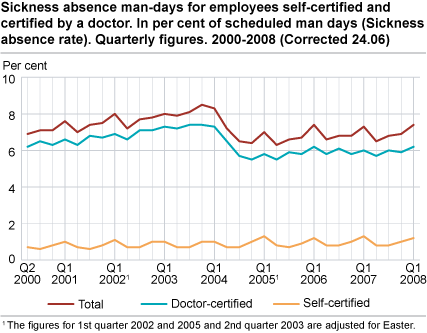Content
Published:
This is an archived release.
Sickness absence unchanged
The sickness absence rate was 7.4 per cent in the first quarter of 2008 compared to 7.3 per cent in the first quarter of 2007. The effect of Easter falling in the second quarter in 2007 and in the first quarter in 2008 means that in practice the sickness absence remained unchanged.
The sickness absence rate was 5.9 per cent for men and 9.3 per cent for women, both more or less unchanged from the first quarter last year when the Easter effect is taken into account.
The sickness absence in the first quarter of 2008 was about 3.7 per cent lower than in the first quarter of 2001, the year of the implementation of the agreement on an inclusive labour market.
In the rest of this article, the figures are not corrected for the Easter effect.
Growth in the construction industry
Looking at the largest industries, the construction industry had the strongest growth in sickness absence of 4.2 per cent. In the real estate industry and transport and communication industry, sickness absence decreased by 1.7 and 0.1 per cent respectively.
Increasing proportion of long-lasting absence
The proportion of sickness absence certified by a doctor and lasting for more than 31 days rose from 55.6 per cent to 59 per cent from the first quarter of 2007 to the first quarter of 2008. As a proportion of the total sickness absence (self-certified and doctor-certified), the self-certified sickness absence fell from 17.2 per cent to 16.4 per cent.
Unchanged in central government
The sickness absence in central government (including health enterprises) remained unchanged. Within this sector, the health care (mainly health enterprises) had a decrease in sickness absence of 0.5 per cent. Within local government, there was an increase in sickness absence in public administration of 4.2 per cent. The sickness absence level remained more or less unchanged in the private sector.
Increased absence among young adult women
Looking at the largest age groups we find the strongest increase in doctor-certified sickness absence from the first quarter of 2007 to the first quarter of 2008 among women aged 35-39. This group had an increase in sickness absence of 6.1 per cent. For women aged 25-29 the increase was 4 per cent. The doctor-certified sickness absence for men aged 30-34 fell by 1.9 per cent in the same period, while men aged 40-44 had an increase of 4.8 per cent.
These results are based on data on sickness absence certified by a doctor, as the survey on self-certified absence does not contain data on sickness absence by age.
Technical informationSickness absence rate and the Easter effect The sickness absence rate measures man-days lost due to own sickness as a percentage of scheduled man-days. Scheduled man-days are adjusted for vacations, which means that the figures are affected by when Easter falls. The quarter in which Easter falls has a lower number of scheduled man-days, thus resulting in a higher sickness absence rate. Rates of change The sickness absence rates are presented using one decimal point. When we calculate the rates of change, we use more decimals in order to get more accurate figures. These will therefore differ somewhat from the rates of change produced when using the published rounded figures. The statistics do not cover self - employed persons . |
Tables:
- Table 1 Sickness absence man-days for employees self-certified and certified by a doctor. In per cent of scheduled man-days (Sickness absence rate). Quarterly figures. 2000-2008
- Table 2 Sickness absence man-days for employees self-certified and certified by a doctor, by sex. In per cent of scheduled man-days (Sickness absence rate). Quarterly figures. 2000-2008
- Table 3 Sickness absence man-days for employees self-certified and certified by a doctor, by industry and type of sickness absence. In per cent of scheduled man days (Sickness absence rate). Quarterly figures. 2000-2008
- Table 28 Sickness absence by type of absence(self-certified or doctor-certified) and duration within the quarter
- Table 33 Change in per cent of the sickness absence rate for employees self-certified and certified by a doctor, by industry and type of sickness absence. Quarterly changes. 2000-2007
Contact
-
Arbeidsmarked og lønn
E-mail: arbeidsmarked@ssb.no
-
Unn H. Høydahl
E-mail: unnh.hoydahl@ssb.no
tel.: (+47) 40 90 23 77

